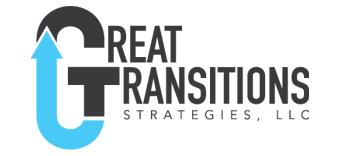Five Checklist Items to Get You Started
Think of your career progression as a series of transitions. In our careers we are constantly looking for what is next. Whether you plan to stay with your current organization long term or move in the near future, building your understanding of what it takes to transition is a worthwhile endeavor.
Here is the starting point I use with clients transitioning, whether it is a promotion, internal change, or jump to a new career field.
My Checklist:
- Timeline – how much time do you have until your next transition or progression step?
- Number – what is the minimum take home pay required to have the lifestyle you want?
- Resume – do you have a resume ready to hand to anyone who asks for it and confident they understand what you can do for them?
- LinkedIn – does your LinkedIn profile accurately portray what you have accomplished and where you are going?
- Networking – have you developed a systematic networking strategy to support your plan?
There are many facets to a career transition. This checklist provides the basics to get you started. Let’s look at each item.
Timeline
How much time do you have before you transition to the next position? Being specific about the timeframe is critical in initiating the process. It also puts you in the mindset of controlling the process.
Starting point: Set a target date for being in a new position. The date can be flexible but I recommend keeping it within a quarter. A goal such as: I will be promoted or have taken an offer by second quarter next year. Why, because it commits you to action and establishes boundaries.
Take out a calendar and do the math
- Choose a date or date window to be in the new position.
- Back it up by vacation days and time off prior to starting.
- What is the day you will walk out of your current position?
Result: You have identified the date you will leave your current position. You now have a timeline.
Number
How much money do you need or want to live your desired lifestyle? Have you done the math?
Determine how your next position impacts the bottom line.
Starting point:
- Assess your current pay, bonuses, and benefits–what is your take home pay?
- Consider benefits such as health care, 401k matching, expense accounts, and commuter costs.
- Construct a proposed budget for your new position taking location into account.
Result: You know your salary and benefit requirements based on location
Resume
How well does your resume represent you in the following two scenarios’?:
- I meet you at a networking event next week and have no knowledge of your current position. I ask for your resume.
- A director internal to your company was referred to you as a good candidate for an opening in their division. She asks you for a current resume.
If the above scenarios gave you anything other than complete confidence, your resume is not ready for prime time.
Starting point:
- Write two resumes; chronological & functional.
- Get professional resume assistance.
- Give them to others to review who have experience in your areas of interest.
Result: You have a resume ready to give to anyone who requests it.
What message does your LinkedIn profile send? Does it accurately portray you and parallel your resume? After you have made a solid effort – get help. LinkedIn should be your professional social media platform of choice.
Starting Point:
- Use a LinkedIn guide that instructs you how to build an All-Star LinkedIn Profile.
- Start searching and connecting. Always connect by using a note to introduce yourself.
Result: Your LinkedIn profile will represent you well and potentially attract recruiters or other professionals.
Develop a Networking Strategy
Only 30% of the available job market is advertised, the rest is hidden. Your network is what is going to get you hired. Look to your network to educate you on organizations, people in the fields you are interested in, and the culture of organizations. There are a lot of individuals willing to assist you. Be deliberate and systematic in growing your network.
Starting Point:
- Start with folks you know; colleagues, friends, and family.
- Seek out and participate in networking events of all types; job fairs, conferences, virtual meetups, and industry or profession-based events.
Result: You will build a network familiar with you and capable of connecting you to credible contacts in career areas of interest.
This is Just the Beginning
How did you feel about each checklist item? If the list gave you some anxiety, it’s time to get started.
What would be the impact on your transition if today you had every checklist item fully under control? Getting a good start can remove a lot of frustration and build a solid foundation for your transition.
The checklist is just the starting point, there is much more work to be done in your transition.
Looking for a coach to assist you through the transition process? Contact me.



